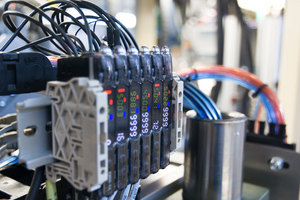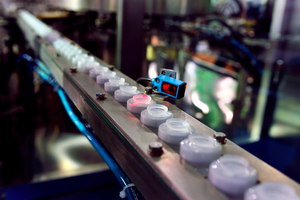
 |
Charlotte Stonestreet
Managing Editor |
| Home> | AUTOMATION | >Sensors | >Get the picture in real-time |
Get the picture in real-time
10 June 2025
Industrial end users must embrace sensor technology as it evolves at pace, asserts Milesh Patel

SENSORS HAVE become commonplace to aid operators in the industrial space to monitor asset health in the quest for preventative and predictive maintenance. Automation is high on the agenda of any manufacturing operation, and sensors are essential to achieving this. Whether measuring pressure, temperature, or vibration, they give a real-time picture of asset health.
In recent years, the cost of sensors has come down, along with the complexity of implementation of this vital technology, making it much more accessible. Equipment manufacturers are continually increasing the level of sensing within products, while end users are demanding greater levels of capability. What has also increased significantly, unsurprisingly, is the sophistication of the sensor technology.
It’s unequivocal that sensors are key in the industrial environment. Being in the know on the latest technologies and applications will enable operators to achieve asset reliability, maximise efficiencies and avoid plant downtime. All of these factors can lead to significant bottom line benefit.
IO-Link technology is still of the moment, but advancement is creeping in
While IO-Link is still the technology of the moment, we are seeing other, more advanced sensing technology come down in price and, as a result, being adopted at an increasing rate.
IO-Link enables access to previously inaccessible status information, enhancing sensor capabilities by providing additional data, like parameters and device status. As IO-Link can self-diagnose and provide information to a central control system, engineers are able to obtain invaluable data with ease to inform their maintenance strategies. This is why this technology has become so popular and more widely implemented.
However, one of the new kids on the technology block is process digital thermography. Powerful thermal imaging cameras can conduct electrical and mechanical diagnostics with precision and accuracy due to a high thermal sensitivity of 100mK. These are Ethernet connected, enabling seamless data transfer, and have alarm output features for timely alerts about any temperature anomalies. They’re compact for easy installation and retrofitting and used for in-process inspection and mechanical monitoring, so it is certainly worth considering this option.
Dramatic reduction in vision sensor technology cost is fuelling adoption
Vision sensing is also being increasingly adopted due to a dramatic reduction in cost.
Where vision sensors were once a very expensive option, costing thousands each, this has come down to around £1000 upwards, so it is much more accessible.
Vision sensors are highly capable compared with other types of sensors, as they combine the image capture ability of a camera with the processing power of a computer. They can analyse images in real-time, signalling to other devices based on set criteria, or be used for data gathering.
They are used to provide an automated solution to solving simple error-proofing applications. Vision sensors can provide presence or absence detection – performing binary functions like yes/no – and detect defects. Defects can then be sorted into different categories based on set features. Vision sensors can also correctly identify parts with variation and are used for object counting to ensure the right number of components are present in a kit.
All of this advanced technology is available in a user-friendly, no-code setup device, which can perform multiple tasks simultaneously and handle a variety of environments with simple integration. Vision sensors are a viable single replacement for multiple laser-based sensors and provide a high degree of accuracy, making them a solid and reliable option that has now become a cost-competitive choice.
Carefully consider sensor implementation to unveil the required data
The accessibility of sensor technology in terms of lower cost and ease of implementation and integration is certainly driving adoption. But in the quest for more data, often, either the actual purpose of it and what it will be used to inform isn’t clear. Or, companies are missing the opportunity to glean what information is already available within the plant itself. There is usually a glut of data sitting in silos in factory assets that, with the right knowledge and solutions, can be accessed and used. Then, the right sensor technology can be planned to help fill in the gaps to help achieve a better holistic picture of production line performance or asset health.
It is always wise to prioritise the most critical assets that would cause the most issues in the case of failure. For those just entering or dipping a toe in the monitoring world, approaching it in this way provides a great test case for other plant assets and is the quickest route to tangible results.
The increased adoption of advanced sensor technologies, with greater levels of intelligence, is underpinned by the greater use of Ethernet-based industrial protocols like TCP/IP, Profinet, and EtherNet/IP. These are now embedded in the current generation of PLCs and make use of these advanced sensors so much easier.
The current state and future of sensor technology is exciting. Keeping abreast of the latest technologies in this rapidly evolving landscape will help manufacturing businesses and industrial operations remain competitive in tumultuous economic times.
Milesh Patel is supplier manager for RS UK and Ireland automation and control, product and supplier management
- New Raspberry Pi 3 Compute Module (CM3) designed for professional engineers
- Latest Raspberry Pi 3
- Prioritise reducing the risk
- 3D-printed PPE
- Sustainable product selection
- RS Components sponsors ‘humansbeingdigital’ art exhibition
- DesignSpark Mechanical
- High power density for IIoT applications
- AM goes mainstream
- Multi-purpose sensor products




















